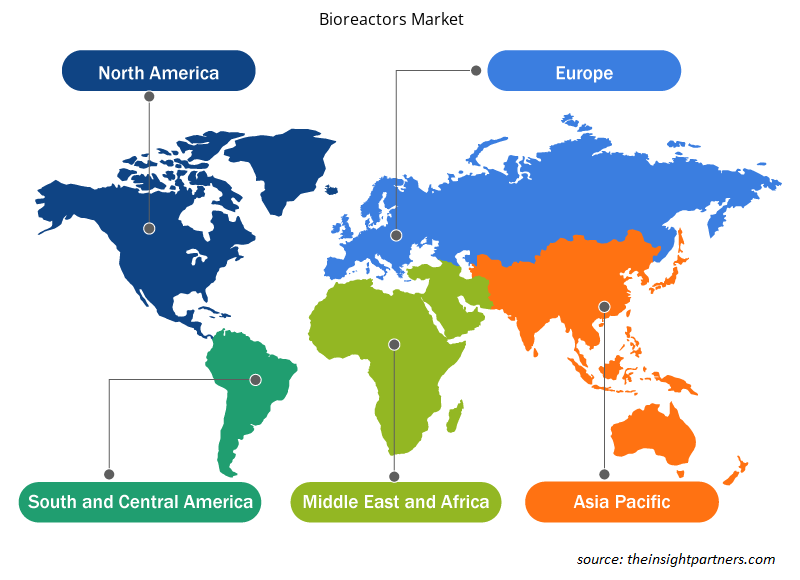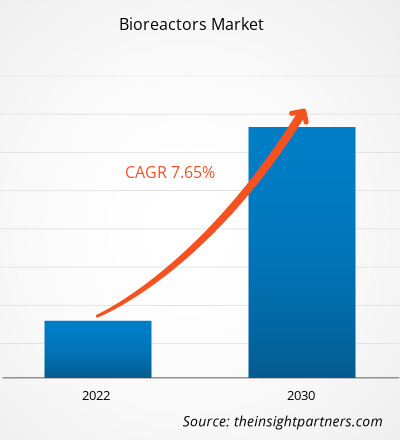生物反应器市场规模预计将从 2022 年的 36.43 亿美元增至 2030 年的 65.7076 亿美元。预计 2022-2031 年期间市场复合年增长率将达到 7.65%。生物反应器的技术进步很可能仍是市场的主要趋势。
生物反应器市场分析
多种细胞类型,如哺乳动物细胞系、干细胞和昆虫细胞,都可以在生物反应器中大规模生长。生物反应器中的细胞培养有许多用途,例如基因和细胞疗法的开发以及疫苗、病毒载体和抗体的制造。在建立这些生物工艺时,需要考虑许多事情,例如优化关键工艺变量、选择最佳进料计划以及保证生物工艺的可扩展性。一次性生物反应器的日益普及以及制药和生物技术行业的快速增长是市场发展的关键驱动因素。
生物反应器市场概况
近年来,制药行业以前所未有的速度扩张。大型制药公司和合同研究组织 (CRO) 正在开发新型疗法和药物,以治疗广泛的疾病。生物制药市场正在扩大。对生物制剂和生物仿制药的高需求推动了该行业的快速扩张。生物制药行业是经济的最大驱动力之一。美国在生物制药研发领域处于世界领先地位,是这些产品的最大市场。根据美国药品研究和制造商协会 (PhRMA) 的数据,美国拥有最多的新型药物专利,并进行了全球一半以上的药品研发(价值 750 亿美元)。除了经济扩张之外,巴西、中国和印度等新兴经济体的研究环境也在快速扩张。该行业的扩张是由于生物制剂审批不断增加、生物仿制药渠道不断增加以及研发投资增加等因素。
定制此报告以满足您的需求
您可以免费定制任何报告,包括本报告的部分内容、国家级分析、Excel 数据包,以及为初创企业和大学提供优惠和折扣
-
获取此报告的关键市场趋势。这个免费样品将包括数据分析,从市场趋势到估计和预测。
生物反应器市场驱动因素和机遇
一次性生物反应器的新兴用途有利于市场增长
一次性生物反应器缩短了生产周转时间并降低了污染的可能性。近年来,一次性生物反应器在当代生物制药工艺中变得越来越普遍,因为它们具有提高灵活性、降低投资和控制运营成本的卓越能力。此外,许多企业已经制造出可以生产多种药物的一次性生物反应器。例如,赛默飞世尔科技公司于 2021 年 3 月推出了 3,000 L 和 5,000 L HvPerforma DvnaDrive 一次性生物反应器。一次性生物反应器的一个显著优势是缩短了验证时间。由于一次性生物反应器在上游生物加工中的使用越来越多,市场正在扩大。例如,Sartorius AG 提供各种一次性生物反应器。该公司提供 50-2000L 的 Biostat STR 和容量为 10-15 mL 的微型生物反应器的 Ambr 15。一次性生物反应器在药品制造中的接受度越来越高,这推动了生物反应器市场的发展。
个性化医疗需求不断增长
精准医疗利用患者的基因信息为特定疾病提供定制化治疗。由于多种慢性病发病率不断上升,对生物制剂、罕见病药物和定制治疗的需求激增。例如,美国国家人类基因组研究所 (NHGRI) 于 2020 年 2 月宣布将启动一项专注于基因组学和精准医疗的新计划。该计划的主要重点是创新使用基因组学和信息学工具来改善疾病诊断和治疗。预计在预测期内,由于对个性化医疗的需求不断增加,生物反应器市场的参与者将获得巨大的增长机会。
生物反应器市场报告细分分析
有助于得出生物反应器市场分析的关键部分是规模、应用、技术和最终用户。
- 根据规模,生物反应器市场分为实验室规模生产、中试规模生产和全规模生产。实验室规模生产部分在 2022 年占据了最大的市场份额。
- 根据应用,市场分为微生物应用、细胞培养应用和其他。 2022 年,细胞培养应用领域占据了最大的市场份额。
- 根据技术,生物反应器市场分为补料分批生物反应器和灌注生物反应器。补料分批生物反应器部分在 2022 年占据了最大的市场份额。
- 根据最终用户,市场分为生物制药制造商、研发组织和合同制造组织。研发组织部门在 2022 年占据了最大的市场份额。
生物反应器市场份额按地区分析
生物反应器市场报告的地理范围主要分为五个区域:北美、亚太、欧洲、中东和非洲、南美和中美。
美国、加拿大和墨西哥构成了北美生物反应器市场的三个部分。生物制药和生物技术行业对生物反应器系统的需求不断增长、市场参与者的存在以及众多学术和研究机构的研发扩张都是北美生物反应器系统市场增长的因素。此外,由于制药和生物技术公司的研究增加,北美的生物反应器市场预计会增长。加拿大市场因大量在国际上销售产品的制药公司而得到加强。例如,不列颠哥伦比亚省、萨斯喀彻温省、阿尔伯塔省、曼尼托巴省、安大略省和魁北克省的企业包括安进、Xenon Pharmaceuticals、Zymeworks、吉利德科学、雅培、Alphora Research、安进、Apotex、安斯泰来、默克、艾伯维、百时美施贵宝、Caprion Biosciences、Charles River Laboratories、葛兰素史克、Pharma、阿斯利康、百特、拜耳和 Cipher Pharmaceuticals。随着加拿大生物制药行业的显著扩张,市场也随之增长。此外,制药公司通过合作进行的大规模研发 (R&D) 活动带来了对风险基金和中小企业 (SME) 的补充投资。随着为国内外客户提供服务的合同研究组织和合同制造组织 (CRO 和 CMO) 数量的增加,加拿大制药行业市场的范围进一步扩大。
生物反应器市场区域洞察
Insight Partners 的分析师已详尽解释了预测期内影响生物反应器市场的区域趋势和因素。本节还讨论了北美、欧洲、亚太地区、中东和非洲以及南美和中美洲的生物反应器市场细分和地理位置。

- 获取生物反应器市场的区域特定数据
生物反应器市场报告范围
| 报告属性 | 细节 |
|---|---|
| 2022 年市场规模 | 36.43 亿美元 |
| 2030 年市场规模 | 65.7076亿美元 |
| 全球复合年增长率(2022-2030 年) | 7.65% |
| 史料 | 2020-2021 |
| 预测期 | 2022-2030 |
| 涵盖的领域 |
按规模
|
| 覆盖地区和国家 |
北美
|
| 市场领导者和主要公司简介 |
|
生物反应器市场参与者密度:了解其对业务动态的影响
生物反应器市场正在快速增长,这得益于终端用户需求的不断增长,而这些需求又源于消费者偏好的不断变化、技术进步以及对产品优势的认识不断提高等因素。随着需求的增加,企业正在扩大其产品范围,进行创新以满足消费者的需求,并利用新兴趋势,从而进一步推动市场增长。
市场参与者密度是指在特定市场或行业内运营的企业或公司的分布情况。它表明在给定市场空间中,相对于其规模或总市场价值,有多少竞争对手(市场参与者)存在。
在生物反应器市场运营的主要公司有:
- 赛多利斯公司
- PBS 生物技术
- 默克公司
- 赛莱克斯国际有限公司
- 通用电气公司
- 赛默飞世尔科技公司
免责声明:上面列出的公司没有按照任何特定顺序排列。

- 了解生物反应器市场的主要参与者概况
生物反应器市场新闻和最新发展
生物反应器市场的评估是通过收集一手和二手研究后的定性和定量数据进行的,其中包括重要的公司出版物、协会数据和数据库。下面列出了生物反应器市场的一些发展情况:
- Getinge 正在扩展其生物反应器产品,推出一次性生产反应器 (SUPR) 系统,该系统最初提供 50 升和 250 升两种规格。SUPR 系统基于与 Getinge 小型生物反应器相同的成熟平台,可帮助运营商更快地将救命药物推向市场,旨在改善人们的生活质量。(来源:Getinge,新闻稿,2024 年)
- 全球技术和软件领导者艾默生与领先的国际生物制药公司 Sartorius 合作,将 Sartorius 的 Biostat STR 第三代生物反应器系列与艾默生的 DeltaV 分布式控制系统 (DCS) 进行原生集成。用于艾默生 DeltaV 的 Biostat STR 第三代是 Biostat STR 第三代系列的一个变体,是一种预先设计的解决方案,可提供直观的连接性,以加速和简化将改善患者生活质量的疗法推向市场的过程。(来源:艾默生电气公司,新闻稿,2023 年)
生物反应器市场报告覆盖范围和交付成果
“生物反应器市场规模和预测(2020-2030)”报告对以下领域进行了详细的市场分析:
- 生物反应器市场规模及全球、区域和国家层面所有主要细分市场的预测
- 生物反应器市场趋势以及市场动态,如驱动因素、限制因素和关键机遇
- 详细的 PEST/波特五力分析和 SWOT 分析
- 生物反应器市场分析涵盖主要市场趋势、全球和区域框架、主要参与者、法规和最新的市场发展。
- 行业格局和竞争分析,涵盖市场集中度、热图分析、知名参与者以及生物反应器市场的最新发展
- 详细的公司简介
- 历史分析(2 年)、基准年、预测(7 年)及复合年增长率
- PEST和SWOT分析
- 市场规模、价值/数量 - 全球、区域、国家
- 行业和竞争格局
- Excel 数据集
近期报告
相关报告
客户评价
购买理由
- 明智的决策
- 了解市场动态
- 竞争分析
- 客户洞察
- 市场预测
- 风险规避
- 战略规划
- 投资论证
- 识别新兴市场
- 优化营销策略
- 提升运营效率
- 顺应监管趋势























 获取免费样品 - 生物反应器市场
获取免费样品 - 生物反应器市场